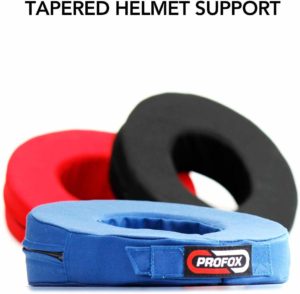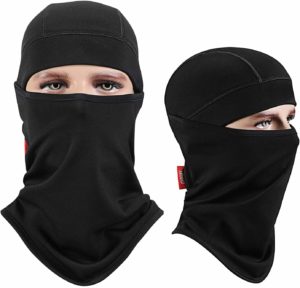Ever wondered how to make a motorcycle helmet quieter?. Helmets are a great companion to motorcycle riders on the highway. They provide the protection and safety that we need as riders.
However, a noisy helmet can rather compound your problems on the road, especially with wind noise. If a helmet is not quite enough to provide a soundproof ride, then it can be a nuisance that needs to be replaced or soundproof in some way.

On the highway, noise levels can get pretty high and as high as 115 dB, and research has shown that hearing loss starts at a noise level of 85 dB.
With this data, exposing yourself to such an amount of high-level noise could result in hearing loss with regular exposure.
To avoid a hearing problem, it is better to soundproof your helmet than to be sorry.
Here, I will look are some DIY ways to make a noisy helmet quieter for reduced noise rides.
How to Soundproof a Motorcycle Helmet
Reducing the wind noise in a motorcycle helmet is possible with some DIY ways. You can use soundproofing materials that are for the helmet or your heat to minimize this type of noise. Below are some of the ways to reduce motorcycle helmet noise.
Wear a Helmet that Fits Your Head Properly
When you are on the road, especially on the highway, you will encounter a lot of wind noise. As you already may know, there are two common types of noise and these are airborne and impact noise.
You will be encountering a lot of airborne noise and this type of noise travel by air.
Therefore, wearing an improperly fitted helmet will expose you to a lot of turbulence. If the helmet is not fitting your head properly, with a lot of space inside the helmet, especially with a loose helmet, wind noise will fill the inside causing you to experience the noise.
Ensure that the helmet is properly fitted on your head, especially around the neck area where air can easily pass through the helmet.
Besides the noise problem you might ensure with an improperly fitted helmet, you also could be putting your own safety at risk.
2. Use a Motorcycle Helmet Wind Blocker
The neck area of the helmet can be vulnerable to wind turbulence. If your helmet does have a significant neck padding or is there but not covering enough, it will be better if you get a helmet neck support to add to the neck area to block the wind.

This motorcycle helmet wind blocker is able to provide neck support and comfort for riders.
If you wish to purchase one, I will recommend you check out these helmet neck supports; the NOJ quiet rider helmet skirt and PROFOX racing helmet support that many riders like and they are lightweight and effectively reduce wind noise effectively while you are riding.
Wear Motorcycle Helmet Earmuffs
Earmuffs are mainly made for the cold weather to protect your ears. If you are a rider, you can use earmuffs to protect your ears against the wind noise while you ride. They protect your ears against the harsh winter weather and wind noise.
Wear noise canceling Earplugs for Motorcycle Riders
At high speeds, the wind noise becomes extremely high and this can make it difficult to soundproof the wind noise in the helmet. Noise-canceling earplugs can be another effective way to combat this.
Earplugs are comfortable to wear with your helmet. You don’t need a larger helmet to use them. You will just be needed to plug them in and put on your helmets.
Most of these earplugs are made with silicone. It does an awesome job of absorbing sounds coming into your helmet. Plus, they are even small in nature and won’t make your helmet big in any way. Here is a post on 10 Earplugs that Block All Sound. You may check it out.
Stuff your Helmet with Fleece
Stuffing your helmet with fleece will act as a wind blocker. Try stuffing some fleece behind the cheek pads of your helmet. This will make a tighter seal around your face and block any wind noise trying to get into the helmet.
Wear a Scarf
Scarfs are not only for fashion but in this case, you can use a scarf as a wind blocker while riding.
Wearing a scarf covering your ears will block the wind noise that is passing through your neck into the helmet or just any opened vent on the helmet.
Ensure to wear it high enough to meet the bottom of the helmet to create a shield that will prevent the noise from traveling up.
fill Your Ear Holes with Memory Foam
Similar to the fleece idea, you can stuff some memory foam into the ear pockets of your helmet. Simply cut something like this memory foam pad into a small enough dimension so it fits in your helmet.
Before you put your helmet on, squeeze the foam tight with your hands up against your ears while you quickly slide it on. The foam will expand and cover your ears.
Wear Face Mask
These motorcycle face masks are specifically made for motorcycle riders to block wind noise from entering the ears and nose. Wearing a face mask on the road will protect you against noise, bugs, dust, and debris.

This face mask can also act as a chin skirt to protect your neck as well against cold air, especially in winter.
Adjust your wind Screen
If you have a windscreen, try adjusting it to effectively shield you against the opposing wind noise. You can use a windscreen spoiler which will act as an extension deflector for your motorcycle windshield.
It is an adjustable windshield that you can fix above your original windshield and heighten for better rider safety.
It gives you the additional protection you need against rain and wind.
Close Your Helmet Visor
Any opening in your helmet while riding will significantly enhance wind noise.
Therefore, make sure you ride with your visor closed and securely sealed all the way around your face. Also, close all air vents on the helmet that bring in the most air into the helmet. As noise travels through the air.
If your helmet visor is not sealed properly or can’t seal all the way, it will create unnecessary turbulence and noise.
Buy a Quiet Helmet
Motorcycle helmets are designed differently. Some are more soundproof than others. If reducing noise in your existing helmet is a hustle to you and you have some money to invest, I will suggest you acquire a quiet motorcycle helmet instead.
These types of helmets are made to be able to reduce wind noise as much as possible while riding.
When a quiet helmet is combined with either of the above techniques, the noise is reduced to almost zero. You will enjoy riding your bike for longer distances and at high speeds.
Quiet helmets have aerodynamic technologies that are specifically designed to reduce wind turbulence.
You may check out my recent post on the best quiet motorcycle helmets under $200.
If you are looking for a quiet helmet on the high end too, you may check out this Shoei Neotec II Helmet on amazon.
Types of Motorcycle Helmets
motorcycle helmets are grouped into two common types. These are full-face motorcycle helmets and modular motorcycle helmets.
Depending on the type of helmet you use, your noise levels will reduce accordingly.
1. Modular Motorcycle Helmet
The modular helmet is designed with a removable chin guard. This helmet type is designed with adventure-seeking riders in mind. You can easily remove the chin guard to give the helmet an open-face design.
To make this type of helmet soundproof, you need to install the chin guard when you are riding because it is the only way you can shut the wind noise off from entering the helmet to getting to your ears.
Similar Reads:
2. Full-Face Motorcycle Helmet
The type of motorcycle helmet usually is designed to cover the entire head. The eye area is covered with a visor to protect your eyes from sunlight and other debris like dust and stuff when on the road.
One of the outstanding features of this motorcycle helmet type is the chin guard or bar whose function is to provide extra protection.
The full-face helmet type tends to be more soundproof or quieter than the modular type. This is because it covers your entire head and thereby reduces the chances of noise passing through it.
if you opt for this type of helmet, it is recommended you select an anti-fogging visor to prevent distortions on your vision.
- How to Chew Quietly While Eating-Effective Tips - April 14, 2023
- Why is My Clutch Pedal Squeaking – Causes & Fixes - April 14, 2023
- Propane Tank Making Hissing Noise (Solved) - February 25, 2023

